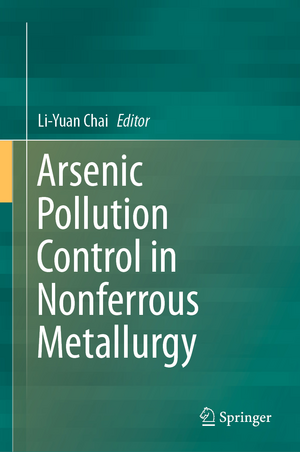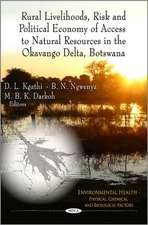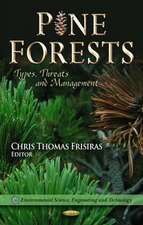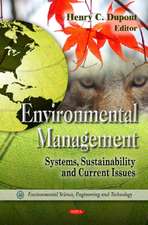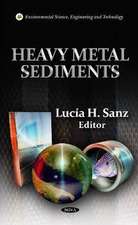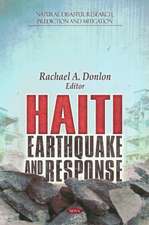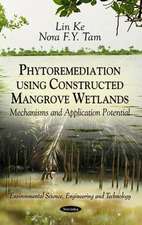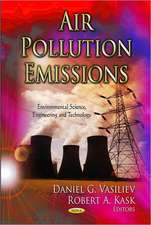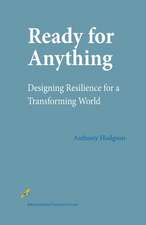Arsenic Pollution Control in Nonferrous Metallurgy
Editat de Li-Yuan Chaien Limba Engleză Hardback – 25 mar 2019
This book introduces arsenic pollution control technologies for aqueous solution and solid wastes produced by the utilization of arsenic-containing materials. It systematically discusses the principles and technologies of arsenic pollution control based on the author’s 16 years of research on arsenic, to help readers gain an understanding of various aspects of arsenic pollution control, including the pollution source distribution of arsenic in typical smelters, arsenic behaviors and pollution control technologies in aqueous solution and solid waste, and clean unitization of arsenic-containing materials.
| Toate formatele și edițiile | Preț | Express |
|---|---|---|
| Paperback (1) | 637.13 lei 22-36 zile | |
| SPRINGER LONDON – 4 iun 2019 | 637.13 lei 22-36 zile | |
| Hardback (1) | 643.34 lei 43-57 zile | |
| Springer Nature Singapore – 25 mar 2019 | 643.34 lei 43-57 zile |
Preț: 643.34 lei
Preț vechi: 756.86 lei
-15% Nou
Puncte Express: 965
Preț estimativ în valută:
123.10€ • 128.87$ • 101.86£
123.10€ • 128.87$ • 101.86£
Carte tipărită la comandă
Livrare economică 07-21 aprilie
Preluare comenzi: 021 569.72.76
Specificații
ISBN-13: 9789811367205
ISBN-10: 9811367205
Pagini: 244
Ilustrații: X, 218 p. 166 illus., 144 illus. in color.
Dimensiuni: 155 x 235 mm
Greutate: 0.5 kg
Ediția:1st ed. 2019
Editura: Springer Nature Singapore
Colecția Springer
Locul publicării:Singapore, Singapore
ISBN-10: 9811367205
Pagini: 244
Ilustrații: X, 218 p. 166 illus., 144 illus. in color.
Dimensiuni: 155 x 235 mm
Greutate: 0.5 kg
Ediția:1st ed. 2019
Editura: Springer Nature Singapore
Colecția Springer
Locul publicării:Singapore, Singapore
Cuprins
Arsenic distribution and the pollution characteristics.- Pollution source distribution of arsenic in the typical smelter.- Arsenic behaviors and pollution control technologies in aqueous solution.- Arsenic behaviors and pollution control technologies for solid waste.- Clean utilization of arsenic bearing materials.
Notă biografică
Liyuan Chai is Dean of the School of Metallurgy and Environment, Central South University(CSU) in China, which has a strong tradition in non-ferrous metal mining, dressing and metallurgy. He is also Director of the Chinese National Engineering Research Center for Control & Treatment of Heavy Metal Pollution and of the National Environmental Protection Engineering Center for Pollution Control of the Nonferrous Metal Industry.
His research focuses on reducing heavy-metal emissions and resource recycling. He has received an award from the National Science Fund for Distinguished Young Scholars and is a Ministry of Education of Yangtze River Scholar Professor. In addition, he was awarded the second prize for National Technology Innovation and second prize for National Technology Progress.Since 2009 he has been the Chinese Chairman of the International Organizing Committee for the East Asia Resources Recycling Technology Conference.
In recent years, he has been responsible for more than 50 major national research projects, including the National Water Special Sub-project, a Major Project of the National Science and Technology Support Program, and National Major Project 863. Many of his technological achievements are now widely applied in non-ferrous metallurgical industries and have contributed to heavy-metal emission reduction and recycling. He holds 93 patents and has published over 250 papers in journals such as Environmental Science & Technology, Water Research, Nano Energy, ACS Applied Material Interfaces, and the Journal of Hazardous Material.
His research focuses on reducing heavy-metal emissions and resource recycling. He has received an award from the National Science Fund for Distinguished Young Scholars and is a Ministry of Education of Yangtze River Scholar Professor. In addition, he was awarded the second prize for National Technology Innovation and second prize for National Technology Progress.Since 2009 he has been the Chinese Chairman of the International Organizing Committee for the East Asia Resources Recycling Technology Conference.
In recent years, he has been responsible for more than 50 major national research projects, including the National Water Special Sub-project, a Major Project of the National Science and Technology Support Program, and National Major Project 863. Many of his technological achievements are now widely applied in non-ferrous metallurgical industries and have contributed to heavy-metal emission reduction and recycling. He holds 93 patents and has published over 250 papers in journals such as Environmental Science & Technology, Water Research, Nano Energy, ACS Applied Material Interfaces, and the Journal of Hazardous Material.
Textul de pe ultima copertă
The control of arsenic pollution has attracted worldwide attention, as it is one of the top 20 hazardous substances, and greatly threatens the human health, ecological balance, and industrial development. Arsenic pollution results from natural enrichment and anthropological activities, especially mining and smelting operations.
This book introduces arsenic pollution control technologies for aqueous solution and solid wastes produced by the utilization of arsenic-containing materials. It systematically discusses the principles and technologies of arsenic pollution control based on the author’s 16 years of research on arsenic, to help readers gain an understanding of various aspects of arsenic pollution control, including the pollution source distribution of arsenic in typical smelters, arsenic behaviors and pollution control technologies in aqueous solution and solid waste, and clean unitization of arsenic-containing materials.
This book introduces arsenic pollution control technologies for aqueous solution and solid wastes produced by the utilization of arsenic-containing materials. It systematically discusses the principles and technologies of arsenic pollution control based on the author’s 16 years of research on arsenic, to help readers gain an understanding of various aspects of arsenic pollution control, including the pollution source distribution of arsenic in typical smelters, arsenic behaviors and pollution control technologies in aqueous solution and solid waste, and clean unitization of arsenic-containing materials.
Caracteristici
Offers a comprehensive overview of the mineralogy, distribution, pollution sources, and characteristics of arsenic pollution Provides information on the behavior, pollution source distribution, and environmental influences of arsenic Presents essential methods and principles for arsenic pollution control
